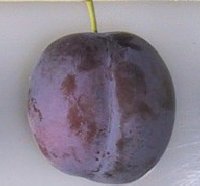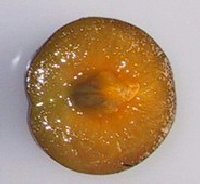PARENTAGE OF BLUE TIT
The parents of Blue Tit are Czar and Old Green Gage. It has taken the superb taste of Old Green Gage and combined it with the cropping reliability of Czar. It was bred by Laxton Brothers of Bedford in 1938.
APPEARANCE, TASTE AND CHARACTERISTICS OF BLUE TIT
The appearance of the tree itself is a clue as to why it suffers less from branch damage compared to most. The branches are held close together in an upright manner with a strong main trunk and individual branches. The leaves are deep green and relatively unaffected by any marks or signs of disease. Blue Tit fully looks the part of a strong growing and healthy tree.
The fruits are slightly smaller than some other varieties, four bites and they are gone! An ideal size, not too small but not too big. The fruits are initially a light green colour which turns to a deep blue-purple as they ripen.

When fully ripe the fruits are deeply coloured all over. Cut one in half and the small stone inside can easily be removed. The fruit flesh a deep orange yellow colour and is quite dense. This is not a fruit which will squish all over the place when you bite into it but at the same releases lots of juice.
As far as taste goes this variety can be used as both an eater and a cooker. The acidity necessary for cooking comes from the skin and if picked a week or so before they are perfectly ripe the flesh retains texture and some form so necessary for a plum pie of crumble.

Let the plums ripen completely and Blue Tit has an eating flavour and texture which equals the best of all plums and gages. It’s juicy and sweet with a perfect plum texture. As with all plums and gages they do not keep well, a week or two at the most. But pick them a week earlier than needed and they will ripen for week in the kitchen to perfection.
This variety is self-fertile although another suitable plum tree nearby (Victoria does well) will increase the yield. The pollination group is D and the blossoms suffer very little from late frosts. It is suitable for all but the coldest parts of the UK.
All the normal pruning rules for plums apply to this variety although it will tolerate a degree of neglect better than others. In early summer, plum trees look especially impressive if they have huge crops of young fruit. But if you forget to ruthlessly thin that fruit for most varieties, the result will be broken branches, a resulting low yield and lots of potential for canker and other diseases to take hold. Blue Tit tends to produce a more reasonable and sustainable crop with greater tree health.
Blue Tit is ideal for growing in the garden or allotment and we would suggest a St Julien A rootstock to give a very manageable tree size of about 3.5m to 4m (11ft to 13ft) after five years. A Pixy rootstock will also do well if your soil conditions are good and the tree is grown in a protected position, producing a 2.5m to 3m (7ft to 9ft) tree after five years. Blue Tit is ideal for growing in a large container on a VVA-1 rootstock.

Ripe Blue Tit plums
Pictures from public sector information licensed under the Open Government Licence v2.0.
POLLINATION PARTNERS FOR BLUE TIT PLUM TREES
Blue Tit plum trees are self-fertile and will produce a more than adequate crop of plums on their own without any other plum trees nearby. If any fruit tree sellers tell you otherwise they will simply be trying to sell you two plum trees where in truth, a single tree of this variety will do fine by itself. However, this variety makes an excellent pollinator for the following other plum trees:
- Belle de Louvain – pollination group 3, self-fertile
- Cambridge Gage – pollination group 3, partially self-fertile
- Czar – pollination group 3, self-fertile
- Farleigh – pollination group 3, self-fertile
- Haganta – pollination group 3, partially self-fertile
- Langley Bullace – pollination group 3, self-fertile
- Merryweather – pollination group 3, self-fertile
- Opal – pollination group 3, self-fertile
- Reine Claude de Bavay – pollination group 3, self-fertile
- Shropshire Prune – pollination group 3, self-fertile
- Victoria – pollination group 3, self-fertile
BUYING A BLUE TIT TREE
Blue Tit is available for sale in some garden centres though by no means all, it is however gaining in popularity. It is unlikely to be found in supermarkets and diy stores. It’s widely available online as a bare-rooted tree and occasionally container-grown. No particular supplier stands out against the others for this plum tree, just choose a well known stockist to buy this plum tree.
SUMMARY CHARACTERISTICS OF BLUE TIT
USE: Both eating and cooking
SKIN COLOUR / TEXTURE: Deep blue when ripe
FLESH COLOUR: Deep orange / yellow
TASTE AND TEXTURE: When fully ripe it is juicy, sweet with a medium firm texture
FRUIT SIZE: Slightly below average, great for kids and adults
TREE SIZE: Average size depending on rootstock and conditions
REGULARITY OF CROPPING: More regular than most other plums and gages
POLLINATION: Group 4, self-fertile
AWARDS: RHS AGM
SPECIAL FEATURES: Multi-purpose plum with superb fruits, good disease resistance
FLOWERING AND FRUITING TIMES: The average flowering time (optimum time for pollination) and date when fruits are ripe in the UK for the Blue Tit tree are set out below. If you have set your home town we can give you a more accurate estimate, if you have not set your home town (do it now by clicking here) the dates below will be the average for the UK.
Your town has not been set, the average main flowering time for Blue Tit
in the UK is the third week of April. Fruit will be ready for picking in the second to third weeks of August.
Click here if you want to set the dates to your home town.
Flowering and fruit picking dates vary according to the weather in any particular growing season so the above dates may well change slightly from one year to the next. The flowering date above is when the plum tree produces the maximum number of blossoms, it will also produce blossom, although less, a week or two either side of the date given.
Rootstocks and Size
Pests and Disease
Guide to Planting
Pollination Groups
Care Plan and Pruning
Pruning Older Plum Trees
Top Ten Plum Tree Varieties
Plum Tree Questions and Answers
BLUE TIT PLUM TREE
By David Marks
Plum trees are generally healthy fruit trees but for the newcomer they have two areas of weakness. Firstly they produce too much fruit in some years causing damage to branches, sometimes severely so.
Their second general weakness is susceptibility to canker which, over time, weakens them and opens them up to a range of other infections. If the beginner can avoid these two problems then they are far more likely to enjoy growing their plum trees. One variety which minimises these problems is Blue Tit. With regular, medium sized crops and good disease resistance this variety is ideal for the beginner.